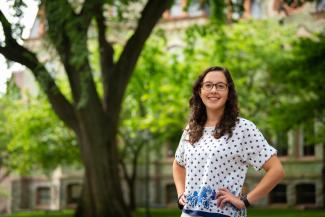
Through a spring Center for Undergraduate Research and Fellowships grant, rising senior Hannah De Oliveira explored archives across the country to study viewpoints within Japanese American internment camps.
____
Who
Hannah De Oliveira has always loved history—of that, she was certain. She grew up exploring history museums for fun, often dragging family to them on vacations.
“I still do this,” she quips.
But when time came to pick a college major, she says, she was advised to steer away from it and pick something that might propel her career more. After one semester undeclared, she declared her major as history anyway.
“Despite what people might think, history majors end up in a variety of jobs—not just in museums or as historians,” she says. “I am really grateful that I didn’t let other people’s opinions of being a history major sway my decision to commit to it. Being a history major and studying history at Penn has been one of the most rewarding experiences of my life.”
After transferring from Ithaca College during her sophomore year, she recalls skimming the Penn History Department’s course list and stumbling upon “Wartime Internment of Japanese Americans,” taught by Professor of History and Asian American Studies Eiichiro Azuma, who is now an advisor for her research about internment. “‘This could be a new topic to learn about,’” she remembers thinking. Through the course of the semester, she found it so “interesting and intellectually stimulating,” recognizing its unique position as a subject in the context of World War II—a mammoth period of study with many moving parts.
What
In the spring, De Oliveira received a grant from the Center for Undergraduate Research and Fellowships, as well as funds from the History Department and the Andrea Mitchell Center for the Study of Democracy, to study the interactions between different groups in Japanese American internment camps. She spent two weeks in the archives at the University of California, Berkeley, examining microfilm reels from the War Relocation Authority and meeting minutes from block managers in the camps, particularly the Manzanar camp in California. She spent part of her summer in the National Archives, in Washington, D.C., looking at government sources, examining materials related to the Poston Internment Camp in Arizona, which was the largest of the 10 camps.
Her goal with her research is to understand what factors influenced viewpoints of Japanese Americans on the war and their identities—whether these opinions were shaped by generational, class, educational, or religious variables, or perhaps from specific encounters with Army officials.
“I’m trying to understand why these points of view existed, how they responded, and how they interacted with one another,” De Oliveira says. “A lot of times, I think it’s very easy to say, ‘Oh, these people were anti-American, these were pro-American,’ but I think there’s more nuance to who is involved in those groups. It’s not ‘People from Japan were automatically anti-American.’ It’s not the case—it’s a misconception.”
Her research will culminate in an honors thesis that she plans to finish by December.
Why
De Oliveira recognizes that Japanese American internment has been widely studied—even by her adviser. “But I think there’s no such thing as something being studied enough,” she explains. “I think there’s always something new to find, and two people can look at the same source and draw completely different conclusions. I think it’s important to keep adding new perspectives into the field and this topic in general.”
In some cases, De Oliveira says, narratives may have been downplayed by the government, and a lot of perceptions are baked in over time—like the sense that, following the reparations issued in the 1980s, Japanese Americans were “loyal.” She points to a commonly told celebratory tale of the 442nd regiment of all-Japanese American troops—mostly “Nisei,” or second-generation Japanese Americans—who fought in Europe during the war.
“Those stories were highlighted to the point where it seems like all Japanese Americans were supportive of the U.S. and never wavered in their loyalty,” De Oliveira says. “I think it’s important to understand that’s not necessarily true, and there’s valid reasoning behind that, and [the importance of] uncovering new voices.”
Read the entire story HERE
